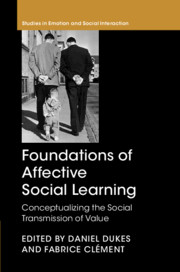Book contents
- Foundations of Affective Social Learning
- Studies in Emotion and Social Interaction
- Foundations of Affective Social Learning
- Copyright page
- Dedication
- Contents
- Figures
- Contributors
- Preface
- A difficult introduction to affective social learning
- Part I On the evolutionary foundations of affective social learning processes
- Part II On human development and affective social learning
- Part III On the mechanics of affective social learning
- Chapter 5 Calibrating emotional orientations
- Chapter 6 Socio-affective inferential mechanisms involved in emotion recognition
- Chapter 7 Learning from others’ emotions
- Part IV Applications of affective social learning
- Conclusion
- Index
- Studies in Emotion and Social Interation
- References
Chapter 7 - Learning from others’ emotions
from Part III - On the mechanics of affective social learning
Published online by Cambridge University Press: 09 August 2019
- Foundations of Affective Social Learning
- Studies in Emotion and Social Interaction
- Foundations of Affective Social Learning
- Copyright page
- Dedication
- Contents
- Figures
- Contributors
- Preface
- A difficult introduction to affective social learning
- Part I On the evolutionary foundations of affective social learning processes
- Part II On human development and affective social learning
- Part III On the mechanics of affective social learning
- Chapter 5 Calibrating emotional orientations
- Chapter 6 Socio-affective inferential mechanisms involved in emotion recognition
- Chapter 7 Learning from others’ emotions
- Part IV Applications of affective social learning
- Conclusion
- Index
- Studies in Emotion and Social Interation
- References
Summary
This chapter provides a theoretical discussion of the boundaries of affective social learning (ASL), focusing on the conditions under which ASL takes place and the processes underlying ASL. In other words, the question is not so much what, but rather how we learn from others’ emotions. I propose three conditions that form a minimal requirement for others’ emotional reactions to have an initial impact on an individual: (1) the source (displaying the emotion and from whom the target learns) needs to show some emotional expression; (2) the target pays attention to the source, and is aware of the source’s focus of attention and the relevance of the emotion expression for him or her; (3) the source needs to put some trust in the source’s judgement or evaluation of the world. I next discuss the conditions under which we are most motivated to learn from others – when we are in an uncertain or ambiguous situation, for example, but also when the target experiences or expresses emotions, which can then be regulated by the source. This form of ASL may form the basis of emotional psychopathology in families, where children’s emotions are often met with depressed, anxious or indifferent reactions by their parents, through which children unintentionally learn inappropriate emotional responses. Different types of learning are then discussed that may be involved in ASL, ranging from fear conditioning to cognitive learning.
Keywords
Information
- Type
- Chapter
- Information
- Foundations of Affective Social LearningConceptualizing the Social Transmission of Value, pp. 165 - 184Publisher: Cambridge University PressPrint publication year: 2019
References
Accessibility standard: Unknown
Why this information is here
This section outlines the accessibility features of this content - including support for screen readers, full keyboard navigation and high-contrast display options. This may not be relevant for you.Accessibility Information
- 3
- Cited by
